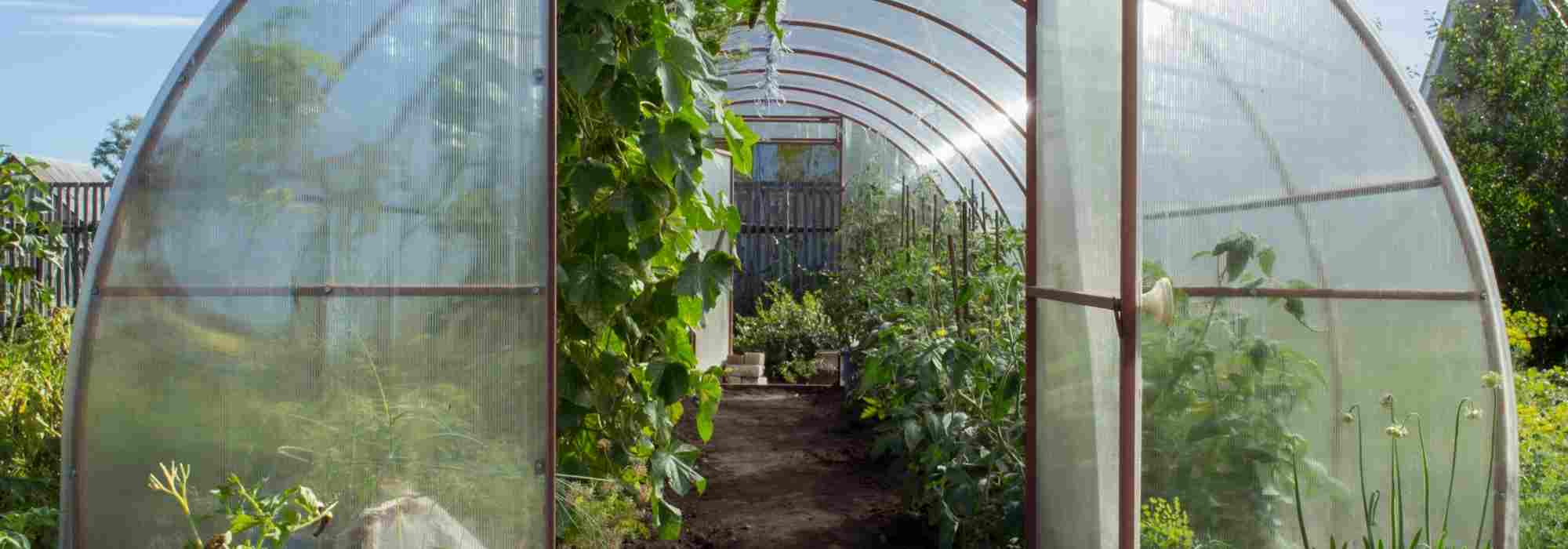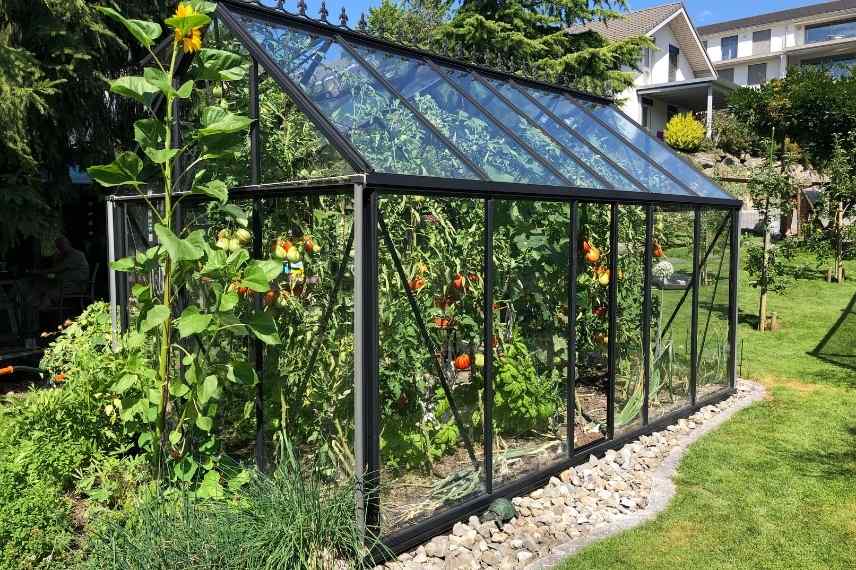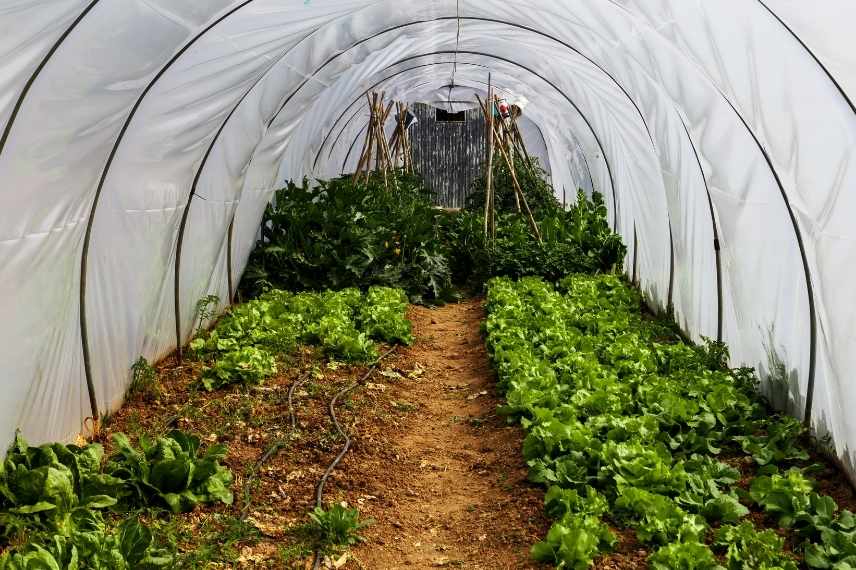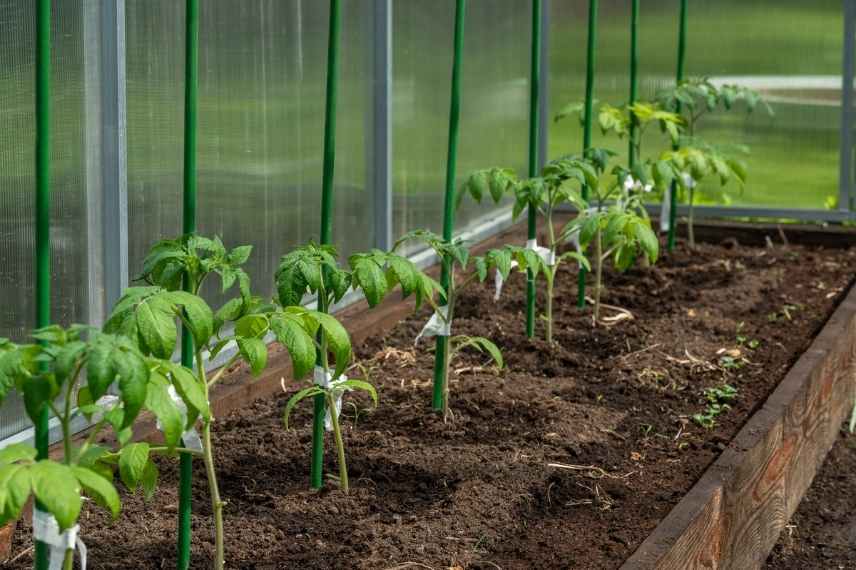
What are the best fruits and vegetables to grow in a greenhouse according to the seasons?
Tips for beautiful harvests all year round in your greenhouse
Contents
Undoubtedly, a greenhouse is an investment for a gardener cultivating their family vegetable plot. However, in all regions, the greenhouse provides much better growing conditions for vegetables and small fruits. Indeed, the greenhouse extends growing and harvest periods, to the point of being a structure usable twelve months a year in regions with a very mild climate, slightly less so elsewhere. Not to mention having healthier crops, less exposed to weather hazards, often sources of diseases or parasitic invasions. Provided you follow good practices and carry out regular maintenance of this greenhouse. And sow or plant the most suitable vegetables and fruits.
Discover the best vegetables and fruits to grow in a greenhouse by season.
The benefits of growing in a greenhouse
The greenhouse offers numerous advantages for growing vegetables and fruits throughout the seasons. It creates a more stable microclimate, where fruits and vegetables grow protected from the many whims of the weather, including extreme temperature variations and storms. Inside a greenhouse, crops are sheltered from heavy spring or autumn rains, wind, late frosts, or sudden cold snaps. Given that these extreme climate conditions, such as high humidity, can trigger diseases or pest infestations, the greenhouse serves as an effective barrier against fungal diseases and other parasitic threats.
Thanks to the greenhouse, you can also start sowing and planting earlier and extend the harvest period. It is indeed possible to sow earlier in spring and later in late summer, even into autumn. Some gardeners in regions with mild winters can even garden year-round, including during winter.

The greenhouse extends growing seasons and protects vegetable plants from bad weather
The greenhouse also provides optimal light exposure and consistent warmth, making it possible to experiment with crops that would otherwise be unfeasible without protection.
Finally, as a gardener, you also benefit since soil work can be carried out even when it’s pouring rain outside.
Greenhouse cultivation in spring for an early start to the season
In spring, when starting your vegetable garden, it’s essential to wait until the soil is sufficiently warm and dry. Indeed, some seeds won’t germinate in cold, overly wet or waterlogged soil. During this season, a greenhouse becomes an invaluable asset: from late winter onwards, it captures the first rays of sunshine and creates a true microclimate. The soil naturally becomes warmer and adverse weather conditions are less restrictive. This allows for earlier cultivation without waiting for better days. A gardener can thus gain several weeks compared to outdoor cultivation, yielding fine early vegetables or bringing forward the enjoyment of some juicy, sweet fruits.
Which vegetables should be sown in a greenhouse in spring?
From February or March depending on the region, in a greenhouse, you can consider sowing the first fast-growing vegetables. Radishes, spinach, lettuces, rocket, early carrots and beetroot can therefore be sown directly in the ground. It’s crucial to ensure the soil is well prepared, slightly moist and enriched with organic matter such as compost.
These vegetables will germinate fairly quickly, as the seeds benefit from the greenhouse’s “cocooning” effect to get off to a good start. And harvesting begins a few weeks later.
In spring, the greenhouse also allows you to grow your own seedlings of leeks, cauliflowers or broccoli, either in trays or in a nursery bed directly in the ground. Two to three months after sowing, the young plants can be transplanted into the vegetable garden outdoors.
Finally, the greenhouse is also the perfect place to prepare for summer. You can sow summer vegetables such as tomatoes, peppers, chillies, aubergines, cucumbers, courgettes and various squashes. All these sun-loving vegetables are sown in trays or boxes, then transplanted into buckets, well protected from bad weather, frost and wind. Later, they’ll be transplanted into the vegetable garden outdoors, in raised beds, or directly in the ground under the greenhouse once temperatures allow.
If you have enough space, don’t hesitate to plant a few rows of early potatoes which will be harvested 90 days later as new potatoes.

Sowing can be significantly advanced in greenhouses
Early production of some fruits
Strawberry plants in pots or planters under glass can start producing as early as spring, often slightly ahead of those grown outdoors. Perfect for launching the season with a sweet touch!
You can even consider sowing melons and small watermelons in regions with mild climates.
Spring is also the most favourable time to place pot-grown citrus trees such as orange trees, lemon trees, mandarin trees… in the greenhouse before they spend summer outdoors. If they’ve overwintered in a conservatory, placing them in the greenhouse allows for gentle acclimatisation.
Seasonal best practices in the greenhouse
It’s essential to ventilate the greenhouse well in spring during the sunniest days and not forget to close it in the evening, as night frosts are still common in March or April, even May in some regions. Proper ventilation prevents excess humidity, limits diseases, and helps young plants harden off gently.
The greenhouse in summer, full of warmth for vegetables and Fruit
In summer, in the greenhouse, the heat rises quickly, very quickly indeed. It’s a true tropical cocoon offered to vegetables and fruits. The greenhouse is therefore an ideal place for vegetable plants that love warmth and crave sunshine, and are often subject to bad weather outdoors. But beware of the furnace effect. Without ventilation and air circulation, the greenhouse can quickly become an oven, harmful to plants.
Sun-loving vegetables to grow in a greenhouse in summer
In the greenhouse, in summer, it’s peak season for tomatoes, peppers and chillies, cucumbers and courgettes, aubergines. These Mediterranean vegetables adore the heat and perform at their best in a greenhouse. They produce flavourful fruits, generally earlier and in greater quantities than in open ground. However, remember to stake them properly and monitor watering, especially during very hot periods.

Sun-loving vegetables like tomatoes particularly appreciate growing conditions in a greenhouse
You can also continue sowing radishes, but again, watering is essential. You can also sow autumn salads like certain lettuces, or even curly endives and escaroles. Don’t forget lamb’s lettuce. And, to prepare for autumn, continue sowing leeks, carrots, broccoli, Chinese cabbage, artichokes…
Some aromatic plants also love the warmth of the greenhouse. Parsley, basil, lemon verbena, and coriander benefit from being sown and grown in a greenhouse.
Fruits brimming with sunshine and warmth
For those dreaming of eating their own melons or small watermelons, the greenhouse is essential (except along the Mediterranean and Atlantic coasts). These fruits, often very sensitive to cold at the start, will greatly appreciate the optimal heat and light conditions of the greenhouse.
Strawberries can also continue producing if well-watered and lightly shaded.
Essential practices to adopt in a greenhouse in summer
In a greenhouse in summer, you’ll face a real challenge: preventing it from turning into a furnace. Managing heat and humidity is therefore crucial. Ventilate thoroughly in the morning and evening, or even all day in very hot weather. Regular watering, ideally in the morning, is vital to avoid water stress. And to keep the soil cool, mulching is an excellent reflex!
You must also be very attentive to pest invasions, such as aphids, mealybugs, red spider mites… Vigilance is key to act quickly. It’s also possible to test growing repellent plants and allelopathic plants to effectively combat these pests.
Autumn in the greenhouse to extend the harvest and prepare for winter
Outdoors, the autumn drop in temperatures jeopardises the survival of fruit and vegetables in the garden. The greenhouse will thus extend the summer season until mid-autumn, thanks to the thermal inertia of its walls and the heat accumulated during summer. Some gardeners can therefore continue to harvest summer vegetables until September, or even October. However, winter must also be considered, and the greenhouse allows for preparation before the onset of severe cold.
Vegetables to sow in autumn under glass
In October, you can still sow short-cycle vegetables like radishes. Until mid-October, sowing lamb’s lettuce can also continue, as well as rocket or chicory, or even some winter lettuces (but you’ll need to hurry!). Other options include winter spinach, turnips, or beetroot.
When it comes to planting, consider broccoli, celery, cauliflower, spring cabbages, grey shallots, garlic, and white or red onions.
A few more sweet treats
Strawberries may continue to produce if the young plants are well-maintained. It’s also time to harvest the last melons or perpetual raspberries if they are grown under glass. September is also ideal for planting strawberry plants.
Preparing smoothly for what’s next
Autumn is also a pivotal period in the greenhouse. You should start cleaning it gradually, removing exhausted summer plants and crop residues, and enriching the soil for future crops. You can begin installing winter fleece if nights turn chilly. As for watering, it should be significantly spaced out.
Winter under the greenhouse, a precious refugium
In winter, the greenhouse remains a refugium for hardy vegetables that were sown earlier. These vegetables grow slowly, but they grow. However, we will mainly use the greenhouse to overwinter tender plants.
- Subscribe!
- Contents































Comments